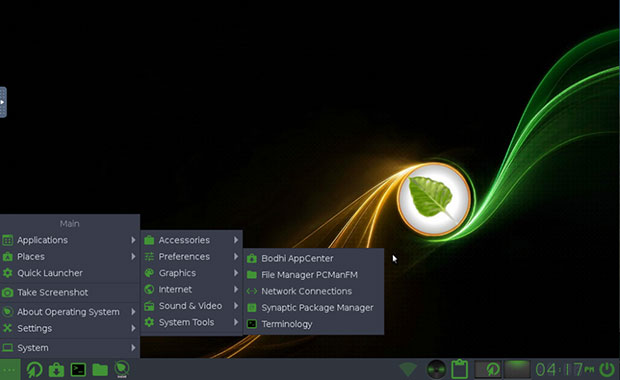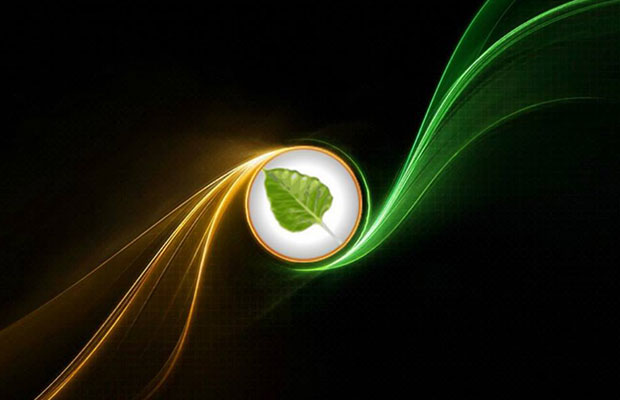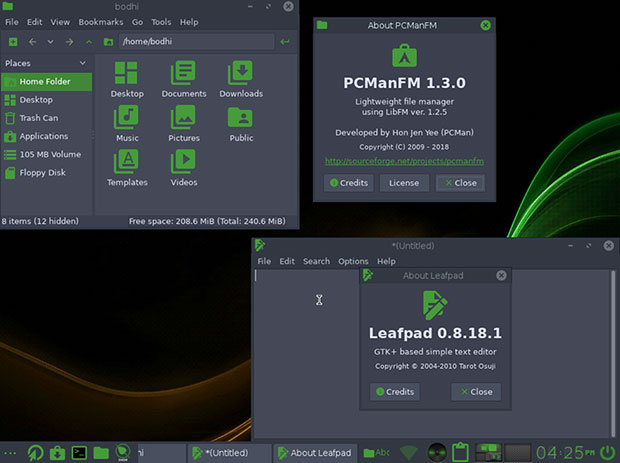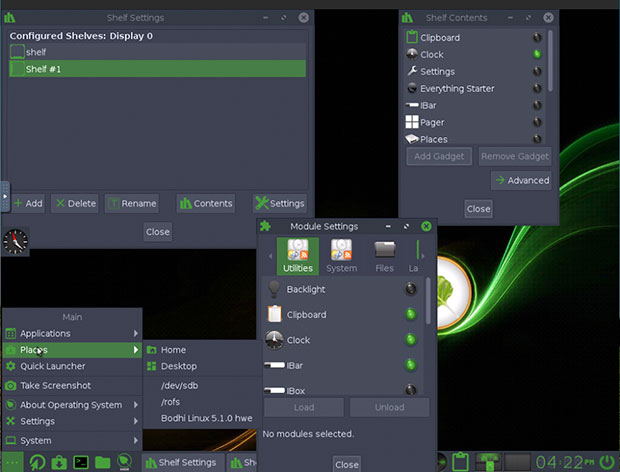Bodhi Linux, previously called “Bodhi OS,” is a novel desktop computing platform for office or home. It offers a radically different desktop environment with a pleasant user experience well worth trying.
Bodhi is a lightweight, Ubuntu-based distribution featuring the Moksha desktop. The new version, 5.1.0, was released on March 25 and is the first under Robert “ylee” Wiley, the project’s new lead developer.
This latest release features several breaks with the U.S.-based Bodhi tradition developed over its nearly 10-year history. I have reviewed this operating system every few years and have never been disappointed in its growth.
In my earliest hands-on assessment, it was Bodhi’s roots with the Enlightenment desktop that piqued my interest. Early on, Bodhi’s creator, Jeff Hoogland, forked Enlightenment 17 to create a new flavor, dubbed “Moksha.” Even in its infancy, it impressed me as something with potential to join the ranks of more popular and productive environments. This desktop remains current and is surprisingly agile.
Partly due to Moksha and partly the result of Hoogland’s philosophical design shift, Bodhi Linux is a viable alternative to traditional Linux OSes. It can change your desktop user experience.

Enlightenment Lingers
When it launched as Bodhi OS some 10 years ago, the distro used Enlightenment, a fledgling new desktop unlike what typically was found in any other Linux distribution. In fact, the name “Bodhi” in Sanskrit means “enlightened” or “the one with sense.”
The Bodhi community forked Enlightenment some 17 years ago in response to the lack of developmental progress from the Enlightenment project. Also, because Enlightenment was relatively heavy, it was not suitable for older hardware. That gave rise to Moksha, actively maintained and updated with the latest Enlightenment libraries.
The philosophy for the distribution is to provide a minimal base system so that users can populate it with the software they want. By default, software loaded onto the ISOs is limited to titles that are essential to most Linux users.
These include a file browser (PCManFM), a Web browser (Midori), and a terminal emulator (Terminology). Software or features that its developers deem unnecessary are not included. To make populating systems with software easy, Bodhi Linux developers maintain an online database of lightweight software that can be installed with one click.
Enlightenment, now available in version 23, is a compositing window manager and desktop shell. It is very unlike other lightweight interface shells such as Xfce and LXDE.
Enlightenment’s roots go back to 1996, when it started out as a project to build a Window Manager for X11. That project has since transitioned to the Wayland Linux graphics protocol. It also evolved to handle mobile, wearable, and TV user interface requirements. It is still viable in Tizen, the Android offshoot platform.
The Enlightenment desktop has a dwindling fan base of users. It is hard to find many distros that offer Enlightenment as an option. One of the more successful distros with Enlightenment as its only desktop is Elive, which I reviewed last spring. It runs a customized version of Enlightenment.
Solid Yet Solitary
Bodhi Linux is one of the very few Linux distros using the Moksha desktop today. Hoogland’s change in developmental direction years ago turned Moksha into a more functional desktop environment than the original Enlightenment release. Moksha became more adaptable to home use and office computing without a dumbed-down user interface.
You would be hard-pressed to find it offered, even as an option, on other Linux distributions today. That is disappointing, as it contributes to a highly modular and flexible computing alternative.
Moksha gives Bodhi Linux its high levels of customization and theme choices. It runs fast and has a post-modern look. It offers many features and options that contribute to its futuristic design and innovative desktop user interface.
This gives the forked Enlightenment desktop an advantage over traditional lightweight Linux desktops compared to choices such as GNOME, Cinnamon, and KDE Plasma. Despite its radical design options, the Moksha desktop is light on resources.
Meet Bodhi 5.1
Bodhi Linux traditionally offered three different ISO images with each release — Standard, Legacy and AppPack. With Release 5.1 another ISO image is added,Hardware Enablement (HWE).
Standard is the platform standard for desktop and workstation computers created in the last decade. Use this release for 64-bit operating systems. The Standard release does not push kernel updates on the user. This ISO performs the standard minimalist software installation that keeps bloat out of the system.
Legacy is the 32-bit release. It utilizes the older 4.9.0-6-686 Linux kernel that is optimized for old (15+ years old) hardware. This kernel also does not include the Physical Address Extension (PAE), which is not supported on many older systems.
The AppPack ISO lets you add exactly what you want with no extra frills by default. This new release includes revamped software offerings. Like the Standard ISO, it comes with Bodhi Linux’s minimalist base install but makes adding software much more convenient.
New to this mix, and one of the major changes in this distro, is the HWE ISO for desktop and workstation computers created in the last decade. It catches up with the newest hardware technologies. If you want kernel updates and newer hardware support for your 64-bit processor, use this release. The 5.1 release features a 5.3.0-42 kernel version.
Other changes replace epad with Leafpad, and Midori with Epiphany, and eliminate eepDater. I am sorry to see eepDater go. It was a unique system maintenance tool.
You could click on eepDater to run a well-tuned system updating application. It showed you all the installed packages and what updates were available for them so you could click the checkboxes for the ones you wanted to upgrade.
Minimalist by Design
The founding philosophy for the distribution was to provide a minimal base system allowing users to populate it with their preferred software. Thus, by default it includes only software that is essential to most Linux users — a file browser, a Web browser and a terminal emulator.
To make populating systems with software easy, Bodhi Linux developers maintain an online database of lightweight software that can be installed in one click via apturl. You can access nearly any software choice you desire. Just run the Synaptic Package Manager included in the default installation.
You can run the software store application but using the Midori browser, which connects you only to the Web-based Bodhi repository. As you would with a Web app, you can click on the Install button to download and install any of the applications housed there.
Check out what is available to access Bodhi’s AppCenter directly from your computer without downloading Bodhi Linux. Or click on the AppCenter tab when visiting Bodhi’s home page.
Modular Motif
At first blush, Bodhi seems to have the traditional Linux panel and familiar appearance. A button on the far left edge of the bar opens an uncluttered menu. Pressing the Control +Alt+M keys displays that same menu as well.
The right end of the panel holds system status icons for Internet connection, battery, clock and calendar, and shutdown options. A virtual workplace switcher displays two workplaces.
Keyboard shortcuts, called “bindings” in Bodhi, are very configurable. Quite a few shortcuts are set by default. You can add your own or change the existing key combinations.
The similarities end there. Essential to the UI is a combination of gadgets, modules, and shelves. The desktop is built around a collection of gadgets and launchers within shelves.
Modules are the engines that drive the gadgets. Gadgets are small applications that either provide system information or perform a specific action. They are very configurable by right-clicking the gadget on the screen.
Right-click on the panel bar to get instant access to several configurations and settings. This is where you can add, remove, or move gadgets that appear on the panel bar.
An inventory of gadgets is provided, but most are not loaded by default. To load modules, go to Main Menu > Settings > Modules.
Arrange different shelves for different virtual workplaces. You can place configurable shelves anywhere along the border of the virtual desktop and can have multiple shelves on the same desktop.
Another Unique Feature
The Personal Application Launcher is a system application for running desktop files that you create yourself. These hidden files are stored in your Home directory at .local/share/applications.
These folder names begin with a period. To see them, open the file manager and press Ctrl+H.
Personal Application Launchers are very useful. For instance, you can create specialized on/off switches to make various desktop functions available with a single click.
PALs are handy for launching a command-line application without having to open a terminal manually and enter the command phrase. The pattern for writing your personalized launchers is easy to learn. Open application launchers come bundled in the installation at /usr/share/applications in a text editor.
Bottom Line
Bodhi is not an out-of-the-box computing platform that allows you to pick up where you left off with your previous Linux distro. The learning curve is minor, but you will need time to get familiar with the software — or lack of it.
In return, you get a core computing platform without software bloat. You also get a modern-looking Linux distro with considerable configuration options but without a staggering number of menu hoops to jump through.
Bodhi Linux is elegant and lightweight. Newcomers to Linux, not knowing how Linux “is supposed to work,” actually may have an easier time gaining proficiency with this Enlightened approach to computing.
The Midori browser, by default, loads a help file with wiki-like links to some startup information. That file is part of the installation content, so new users can access the quick start guide and FAQ topics even if they are not able to access a wireless Internet connection.
Suggest a Review
Is there a Linux software application or distro you’d like to suggest for review? Something you love or would like to get to know?
Email your ideas to me, and I’ll consider them for a future column.
And use the Reader Comments feature below to provide your input!

























































